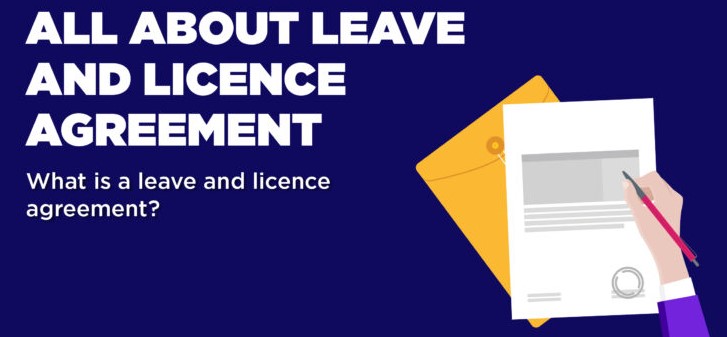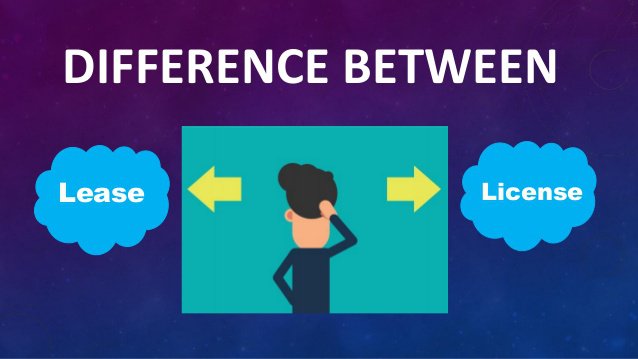
The leave and license agreement is a law governed by the rule of the Indian easements Act, 1882. It makes sure that the use of the premises of a particular property is for the purpose stated in the agreement and nothing else. Property under the leave and licence agreement are under the legal possession of its owner.
In simple words, a leave and licence agreement is a legal document that lets a party allow another party the usage of the licensable assets. These assets include property, for a significant period with no change in the ownership of the asset.
What is a Leave and Licence Agreement?
As mentioned in the section above, a Leave and Licence agreement is a legal document that offers transfer of interest and the rent control of the immovable property from one party to another. This documentation is most common amongst the landlords and tenants in India, especially in the rental housing segment of real estate. However, in the commercial realty segment, the use of these lease agreements is rather common.
One of the major highlights is that a lease helps to create in favor of the tenant with an exclusive interest in the property, while, on the other hand, a Leave and Licence agreement works the opposite, that is, it does not create any interest in the property towards the tenant.
Characteristics of Leave And Licence Agreement
As the agreement falls in the most popular choice among landlords, it’s best to have a deeper understanding and know the properties associated with it. To help you, we have curated a list below that includes the characteristics of leave and license agreement:
- No transfer of interest is created from the owner to the tenant
- The absence of any property right
- The changes such as the amount due as Licence fee, the deposit, and others can be contractually determined by participating individuals
- In most cases, the typical duration of the contract is of 11 months
- The owner happens to maintain higher freedom and rights when it comes to the cancellation and eviction of the tenant
Lease Agreement vs Leave And Licence Agreement: Spot The Differences

To help understand better, here is a tabular explanation of the difference between the lease and the leave and license agreement.
Lease VS Leave And Licence Agreement:
| LEASE AGREEMENT | LEAVE AND LICENCE AGREEMENT |
| It creates an interest in the property | It does not create an interest in the property |
| It grants the tenant an exclusive possession | It only grants permission to occupy the property in question |
| They are not revocable | They are revocable |
| They are not determined by the grantor | They are determined by the grantor |
| A lease is transferable | Leave and license agreement are not transferable |
| It creates inheritable rights | They do not create any inheritable rights |
Leave and Licence Agreement: Legal Meaning
Although the courts have been elaborating on the legal concept from time to time, the basis of a leave and license agreement can be found in the Indian Easements Act, 1882.
In actual words and as per the act – Section 52 of the Indian Easements Act, it reads, “Where one person grants to another, or to a definite number of other persons, a right to do, or continue to do, in or upon the immovable property of the grantor, something which would, in the absence of such right, be unlawful and such right does not amount to an easement or an interest in the property, the right is called a license.”
On the other hand, according to the Supreme Court, if documentation of any property only gives the right to use an immovable asset in a particular way or under certain terms, while the remains in the control and possession of the owner, thereof, it is termed as a license. In simple words, no property interest is transferred to the tenant.
Supreme Court states – “The legal possession, thereof, continues to be with the owner of the property but the licensee is permitted to make use of the premises for a particular purpose. But for this permission, his occupation would be unlawful. It does not create in his favour any estate or interest in the property.”
Note – Since no easement right is granted, the landlord can easily revoke the permission that is granted to the tenant in the agreement. If in case the landlord wished to let out the property in question for a shorter period then, working a rental agreement keeping in mind the leave and license agreement allows them the freedom to do so. As for the tenants, it benefits them as they do not have to serve for longer notice periods to vacate the property of the landlord.
Leave and Licence Agreement: The Rescue of The Landlord

As given and simple as the agreement might seem, there are cases where the owner does not wish to transfer the interest of the property to the tenant, or, the tenant refuses to vacate the assets. What then? What happens if such as such is presented in any scenario?
As per Indian law, it mentions that as long as a tenant is regular about paying the house rent including the other charges, a landlord cannot evict the tenant for about 5 years, until and unless they commit any breach in the agreement and/or are found faulty.
Enter the Leave and Licence agreement! This agreement is often used as a replacement for the good old rental agreement and is frequently used in cities such as Mumbai and the agreement is seen as a much safer option for the landlord as per the observations of experts.
Format of a Leave and Licence Agreement
Here is a typical format of the leave and licence agreement:
This rent agreement is made on _______________ (date) between ________________ (name of the landlord) S/O ______________ (father’s name of the landlord) residing at _______________ (residential address of the landlord) hereinafter called the lessor/owner and first party _____________ (name of the tenant) called lessee/tenant or second party.
The expression lessor/owner and the lessee/tenant shall mean and include their legal heirs, successors, assigns, representatives, etc.
The first party is the owner and in possession of property no. ______________ (address of the rented property) and has agreed to let out the said property to the second party for a monthly rent of Rs._____________/- (amount in words).
This agreement witnesses the following:
- The second party will pay Rs.___________/- (amount in words) every month excluding water and electricity charges.
- The second party will pay a month’s rent in advance which will be adjusted in the following monthly rent.
- The second party will pay the electricity and water charges as per consumption to the owner/landlord.
- The second party shall not lease the property in question to a subtenant under any circumstances without the consent of the landlord/owner.
- The second party shall abide by all the rules and regulations set by the local authorities concerning the lead property and will not get involved in any illegal activities in the leased property.
- This rent agreement stands valid for 11 months starting from ___________ (date of singing the rent agreement).
- This agreement can be extended with the mutual consent of both parties.
- The second party shall not construct inside the rented premises unless it is a temporary decoration, air conditioners, wooden partition, temporary cabins, etc. without the permission of the owner/landlord.
- The second party shall not alter the rented property without the written consent of the landlord/owner.
- The second party shall allow the owner/landlord or an authorized agent to enter the rented premises for repairs, inspection, or other maintenance work if need be.
- The second party shall keep the rented premises clean.
- The second party shall bear the cost of any day-to-day repairs if any.
- This agreement may be revoked before its expiry with a one-month prior notice.
- Both the parties have read and understood the terms of this agreement and shall abide by the same.
- Both parties shall sign and confirm their agreement with their full consent.
Witnesses:
- ________________
- ________________
____________________
SIgnature of the landlord (Lessor)
___________________
Signature of the tenant (Lessee)
Place: _____________
Date: ______________
Leave and Licence Agreement: Points to Remember
The Leave and Licence agreement helps to set a relaxed owner-tenant relationship when it comes to comparing with the regular rental deed. This is widely used in Mumbai as an alternative to leases and similar documents.
In case you are a tenant and do not feel that the document matches your taste, feel free to go through a pre-drafted rental agreement. This is documentation that is comprehensive and covers both tenant and landlord.
The Bottom Line
Leave and license agreements are made when an immovable property is being rented out by the owner. It involves the consent of both the parties (the owner and the tenant) plus any kind of terms and conditions that are legally binding. Also, remember to carefully read through it so that you don’t fall out with the landlord later on. Make sure you sign the papers only if you agree with its terms.
Leave And Licence Agreement? FAQs
1. Is a leave and license agreement similar to the rent agreement?
No, they are different! A leave and license agreement is a document governed by the Indian Easement Act, 1882, the rental or lease agreements are different. Scroll up to know the difference between the two agreements.
2. What is the meaning of leave and license agreement?
The agreement grants the Licensee to use and occupy the licensor’s property, on the other hand, wherein the absence of such permission, such a right would be illegal.
3. Why is the duration of the leave and license agreement for 11 months?
Under the Registration Act, 1908, a rental agreement is mandatory to register in case the period is more than 12 months. Therefore, to avoid stamp duty and registration charges, leave and license agreements are for 11 months.






